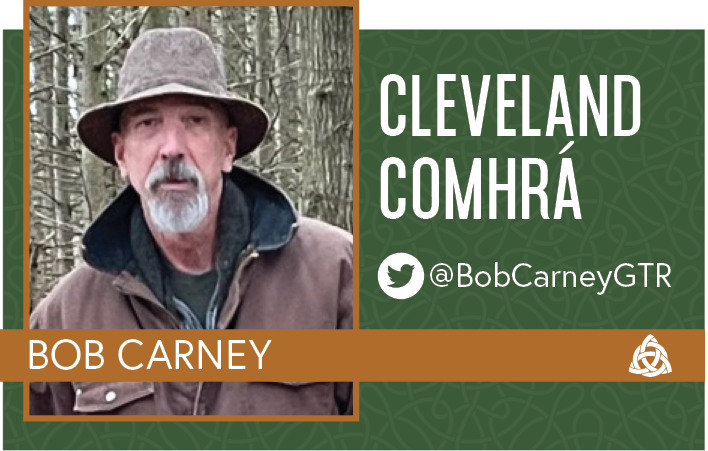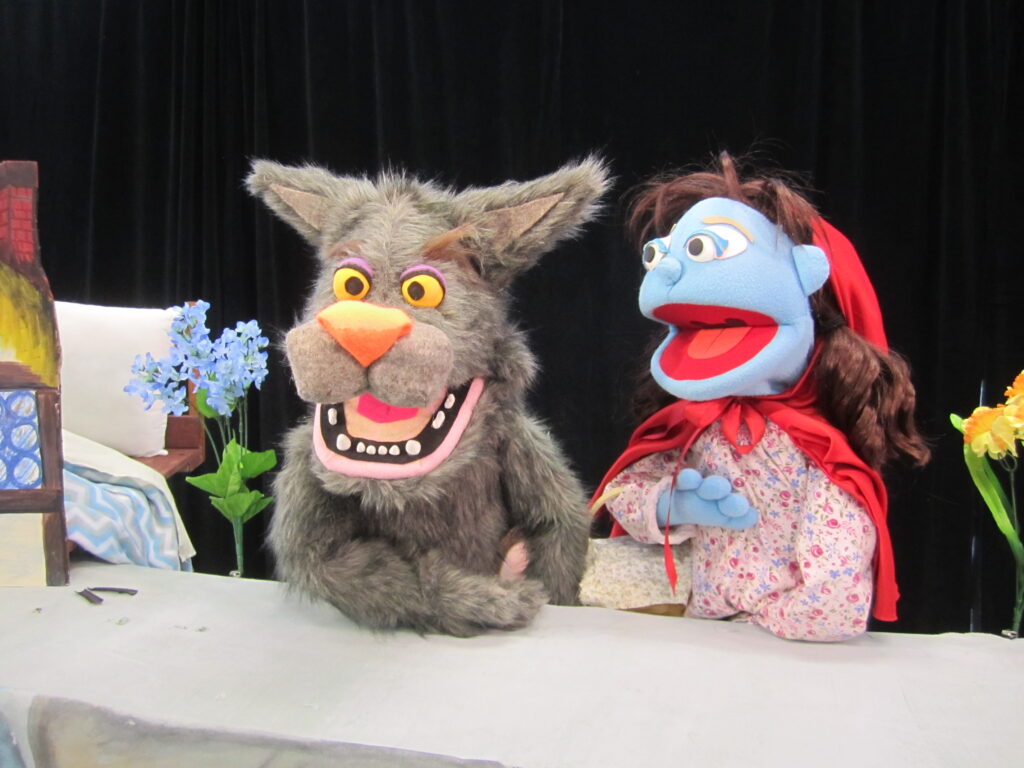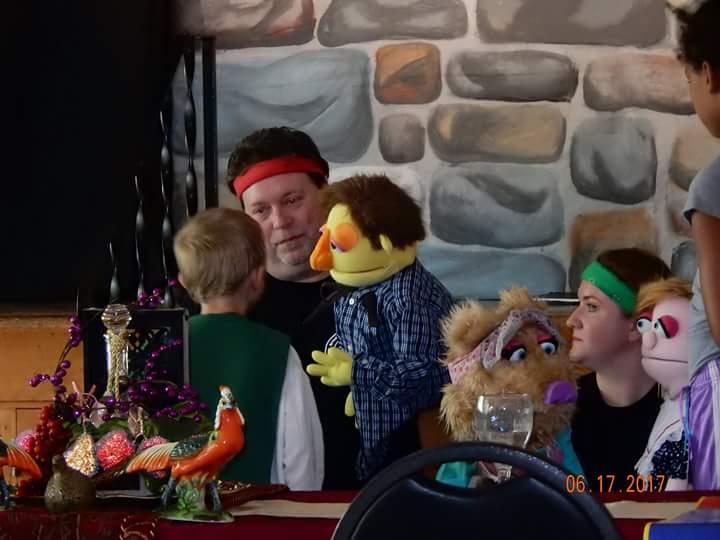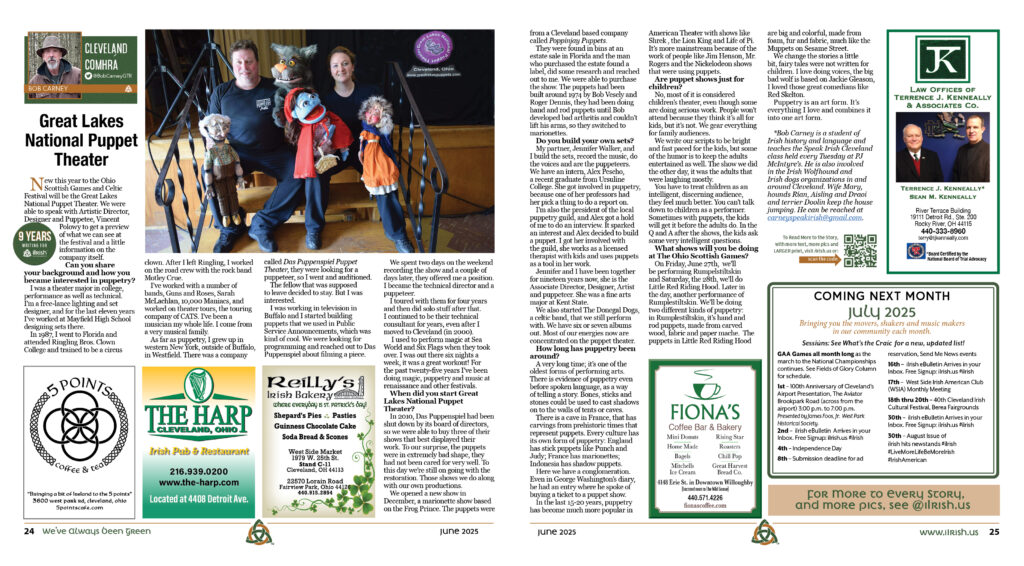
New this year to the Ohio Scottish Games and Celtic Festival will be the Great Lakes National Puppet Theater. We were able to speak with Artistic Director, Designer and Puppetee, Vincent Polowy to get a preview of what we can see at the festival and a little information on the company itself.

Can you share your background and how you became interested in puppetry?
I was a theater major in college, performance as well as technical. I’m a free-lance lighting and set designer, and for the last eleven years I’ve worked at Mayfield High School designing sets there.
In 1987, I went to Florida and attended Ringling Bros. Clown College and trained to be a circus clown. After I left Ringling, I worked on the road crew with the rock band Motley Crue.
I’ve worked with a number of bands, Guns and Roses, Sarah McLachlan, 10,000 Maniacs, and worked on theater tours, the touring company of CATS. I’ve been a musician my whole life. I come from a very musical family.
As far as puppetry, I grew up in western New York, outside of Buffalo, in Westfield. There was a company called Das Puppenspiel Puppet Theater, they were looking for a puppeteer, so I went and auditioned.
The fellow that was supposed to leave decided to stay. But I was interested.
I was working in television in Buffalo and I started building puppets that we used in Public Service Announcements, which was kind of cool. We were looking for programming and reached out to Das Puppenspiel about filming a piece.
We spent two days on the weekend recording the show and a couple of days later, they offered me a position. I became the technical director and a puppeteer.
I toured with them for four years and then did solo stuff after that. I continued to be their technical consultant for years, even after I moved to Cleveland (in 2000).
I used to perform magic at Sea World and Six Flags when they took over. I was out there six nights a week, it was a great workout! For the past twenty-five years I’ve been doing magic, puppetry and music at renaissance and other festivals.

Can You Share Your Background and How You became Interested in Puppetry?
I was a theater major in college, performance as well as technical. I’m a free-lance lighting and set designer, and for the last eleven years I’ve worked at Mayfield High School designing sets there.
In 1987, I went to Florida and attended Ringling Bros. Clown College and trained to be a circus clown. After I left Ringling, I worked on the road crew with the rock band Motley Crue.
I’ve worked with a number of bands, Guns and Roses, Sarah McLachlan, 10,000 Maniacs, and worked on theater tours, the touring company of CATS. I’ve been a musician my whole life. I come from a very musical family.
As far as puppetry, I grew up in western New York, outside of Buffalo, in Westfield. There was a company called Das Puppenspiel Puppet Theater, they were looking for a puppeteer, so I went and auditioned.
The fellow that was supposed to leave decided to stay. But I was interested.
I was working in television in Buffalo and I started building puppets that we used in Public Service Announcements, which was kind of cool. We were looking for programming and reached out to Das Puppenspiel about filming a piece.
We spent two days on the weekend recording the show and a couple of days later, they offered me a position. I became the technical director and a puppeteer.
I toured with them for four years and then did solo stuff after that. I continued to be their technical consultant for years, even after I moved to Cleveland (in 2000).
I used to perform magic at Sea World and Six Flags when they took over. I was out there six nights a week, it was a great workout! For the past twenty-five years I’ve been doing magic, puppetry and music at renaissance and other festivals.
When Did You Start Great Lakes National Puppet Theater?
In 2010, Das Puppenspiel had been shut down by its board of directors, so we were able to buy three of their shows that best displayed their work. To our surprise, the puppets were in extremely bad shape, they had not been cared for very well. To this day we’re still on going with the restoration. Those shows we do along with our own productions.
We opened a new show in December, a marionette show based on the Frog Prince. The puppets were from a Cleveland based company called Poppinjay Puppets.
They were found in bins at an estate sale in Florida and the man who purchased the estate found a label, did some research and reached out to me. We were able to purchase the show. The puppets had been built around 1974 by Bob Vesely and Roger Dennis, they had been doing hand and rod puppets until Bob developed bad arthritis and couldn’t lift his arms, so they switched to marionettes.
Do You Build Your Own Sets?
My partner, Jennifer Walker, and I build the sets, record the music, do the voices and are the puppeteers. We have an intern, Alex Pescho, a recent graduate from Ursuline College. She got involved in puppetry, because one of her professors had her pick a thing to do a report on.
I’m also the president of the local puppetry guild, and Alex got a hold of me to do an interview. It sparked an interest and Alex decided to build a puppet. I got her involved with the guild, she works as a licensed therapist with kids and uses puppets as a tool in her work.
Jennifer and I have been together for nineteen years now, she is the Associate Director, Designer, Artist and puppeteer. She was a fine arts major at Kent State.
We also started The Donegal Dogs, a celtic band, that we still perform with. We have six or seven albums out. Most of our energies now are concentrated on the puppet theater.
How Long Has Puppetry Been Around?
A very long time; it’s one of the oldest forms of performing arts. There is evidence of puppetry even before spoken language, as a way of telling a story. Bones, sticks and stones could be used to cast shadows on to the walls of tents or caves.
There is a cave in France, that has carvings from prehistoric times that represent puppets. Every culture has its own form of puppetry: England has stick puppets like Punch and Judy; France has marionettes; Indonesia has shadow puppets.
Here we have a conglomeration. Even in George Washington’s diary, he had an entry where he spoke of buying a ticket to a puppet show.
In the last 15-20 years, puppetry has become much more popular in American Theater with shows like Shrek , the Lion King and Life of Pi. It’s more mainstream because of the work of people like Jim Henson, Mr. Rogers and the Nickelodeon shows that were using puppets.
Are Puppet Shows Just for Children?
No, most of it is considered children’s theater, even though some are doing serious work. People won’t attend because they think it’s all for kids, but it’s not. We gear everything for family audiences.
We write our scripts to be bright and fast paced for the kids, but some of the humor is to keep the adults entertained as well. The show we did the other day, it was the adults that were laughing mostly.
You have to treat children as an intelligent, discerning audience, they feel much better. You can’t talk down to children as a performer. Sometimes with puppets, the kids will get it before the adults do. In the Q and A after the shows, the kids ask some very intelligent questions.
What Shows Will You Be Doing at the Ohio Scottish Games?
On Friday, June 27th, we’ll be performing Rumpelstiltskin and Saturday, the 28th, we’ll do Little Red Riding Hood. Later in the day, another performance of Rumplestiltskin. We’ll be doing two different kinds of puppetry: in Rumplestiltskin, it’s hand and rod puppets, made from carved wood, fabric and paper mache. The puppets in Little Red Riding Hood are big and colorful, made from foam, fur and fabric, much like the Muppets on Sesame Street.
We change the stories a little bit, fairy tales were not written for children. I love doing voices, the big bad wolf is based on Jackie Gleason, I loved those great comedians like Red Skelton.
Puppetry is an art form.
It’s everything I love and combines it into one art form.







